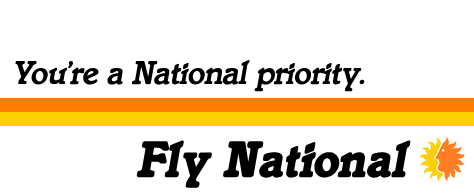Jingle: “You’re A National Priority” (1979)

[sc_embed_player fileurl=”http://brandedskies.com/wp-content/uploads/2013/06/01-Youre-a-National-Priority.mp3″ title=”National Airlines: “You’re a National Priority””]
The two key pronouns in airline advertising — in all advertising, really — are “we” and “you.” Fundamentally, all advertising is a simple proposition: Here’s what we have to offer; here’s what’s in it for you. Some advertising emphasizes the “we,” some advertising emphasizes the “you,” but pretty much all of it falls somewhere on that continuum.
I think airlines get into trouble at the far reaches of the “we” side of the spectrum. Historically, when airlines were fueled by ego as much as aviation kerosene, they could find themselves dangerously out of step with their passengers’ perceptions. “We better be better. We’re Braniff!” is a particularly egregious example; at the time passengers didn’t think being Braniff was anything to be especially proud of.
Indeed, some of the most famous “we” airline slogans suffer from almost breathtaking hubris: TWA’s “Leading the way,” Pan Am’s “America’s airline to the world,” Eastern’s “The Wings of Man.”
Of course, there are famous examples on the “you” end of the spectrum too. United’s “Come fly the friendly skies,” Southwest’s “You are now free to move about the country,” or “Delta is ready when you are.” There’s a risk at this end of the spectrum, too: by promising to be whatever you want it to be, the brand may end up standing for nothing.
Airlines are by no means consistent. From one campaign to another, they might swing from “we” to “you” and back again. And that’s what happened with National.
National’s previous campaign, “Watch Us Shine,” had had a catchy tune, to be sure. But it was also showy and arrogant. It had strayed into the “we” danger zone.
It was time for a course change. At the end of 1978, National dumped Ted Bates after only two years and hired J. Walter Thompson without a pitch. ((You have to feel a little sorry for J. Walter here. Having only just lost Pan Am after more than 30 years, they wanted to prove themselves with another airline account. Little did they know that Pan Am would take this account from them too when Pan Am and National merged barely a year later.)) By the time JWT broke its new campaign in September of 1979, Pan Am had already snapped up more than 50 percent of National’s stock. “You’re A National Priority” would be the airline’s last major campaign.
Philip Dougherty, the New York Times advertising columnist, wrote an uncharacteristically snarky description of the campaign under the headline “A Creative Breakthrough For National Airlines“:
It’s not often that one finds a real creative breakthrough in advertising, but listen to what the J. Walter Thompson Company has managed in its first campaign for National Airlines. In one of its commercials it is using the Golden Gate Bridge and the Statue of Liberty to symbolize the West and East Coasts. What thinking.
Granted, the campaign wasn’t destined to win any Clios. “You’re A National Priority” is a dreadful pun, and worse, not particularly meaningful. But there was still something remarkable about it, as Dougherty admits:
At a time when many airlines are talking about themselves or their employees National puts the passenger first in hopes of breaking through to the consciousness of the frequent traveler.
After decades as a leisure airline — its aircraft had suns painted on their tails, for goodness’ sake — National shifted its focus to business travellers. Business travellers who expect to be treated like the center of the universe. There’s nothing “we” about this campaign. It’s all about “you.”
The jingle emphasizes this not only through its lyrics but through the very fabric of the song. In most verses, the word “you” starts every line — and making “you” a full quarter note ensures that it gets the greatest emphasis. By jingle standards, the structure is actually pretty clever.
But in the end I think National overcorrected. By expanding to London, Paris, Amsterdam, and Frankfurt in the late 1970s, National made itself the third largest U.S. carrier across the Atlantic after Pan Am and TWA. It had entered the big leagues. But “You’re A National Priority” does little to distinguish National from other airlines. It’s a clever line… well, sort of clever. But it’s ultimately empty.
“We” and “you” are the yin and the yang of advertising. In 1977, National went too far in one direction. In 1979, it went too far the other way.
Airline: National Airlines
Title: “You’re A National Priority”
Agency: J. Walter Thompson, New York
Written by: Unknown
Year: 1979
Lyrics:
You are who we stretch our wings for.
You are who we do more things for.
You are who comes first, you see.
You are a National priority.
You are who we smile our smiles for.
You are who we fly more miles for.
You are who you’ll always be.
You are a National priority.
Tell us when and where you want to fly.
Let us know what we can do for you.
National Airlines comes through for you.
You are who we’re in the sky for.
You are who we’re flying high for.
You are who you’ll always be.
You are a National priority.
(Instrumental break.)
You are a National priority!
(Instrumental break.)
You are a National priority!
(Instrumental break.)
Tell us when and where you want to fly.
Let us know what we can do for you.
National Airlines comes through for you.
You are who we’re in the sky for.
You are who we’re flying high for.
You are who you’ll always be.
You are a National priority.
You are a National priority!
Fly National!

This sounds like something Steve Karmen would do. Can’t mistake those singers…
Posted by Ian Sherman on 19 June 2013 at 11:29 pm
It does sound like something Steve Karmen might have done. I don’t think it was him, though — he usually registered his jingles with ASCAP, and this one isn’t listed. Unfortunately I haven’t been able to figure out who wrote this one (although I do know the Hispanic version was arranged by Chico O’Farrill, so… there’s that.)
Posted by Fly the Branded Skies on 19 June 2013 at 11:47 pm